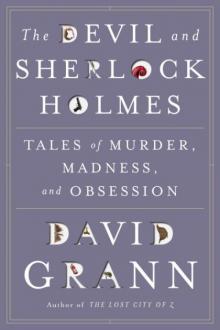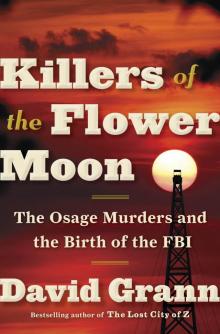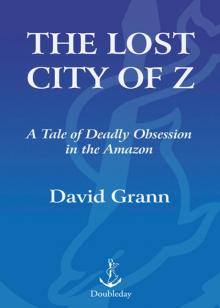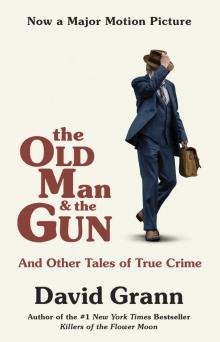- Home
- David Grann
The Devil & Sherlock Holmes: Tales of Murder, Madness & Obsession Page 2
The Devil & Sherlock Holmes: Tales of Murder, Madness & Obsession Read online
Page 2
Nathaniel Hawthorne, who was the American consul in Liverpool in the eighteen-fifties, visited the house one summer, and he later described it in his “English Notebooks”:
We passed through a considerable extent of private road, and finally drove through a lawn, shaded with trees, and closely shaven, and reached the door of Poulton Hall. Part of the mansion is three or four hundred years old. . . . There is [a] curious, old, stately staircase, with a twisted balustrade, much like that of the old Province House in Boston. The drawing-room looks like a very handsome modern room, being beautifully painted, gilded, and paper-hung, with a white-marble fireplace, and rich furniture; so that the impression is that of newness, not of age.
By the time Richard was born, however, the Green family was, as one relative told me, “very English—a big house and no money.” The curtains were thin, the carpets were threadbare, and a cold draft often swirled through the corridors.
Green, who had a pale, pudgy face, was blind in one eye from a childhood accident, and wore spectacles with tinted lenses. (One friend told me that, even as an adult, Green resembled “the god of Pan,” with “cherubic-like features, a mouth which curved in a smile which was sympathetic, ironic, and always seeming to suggest that there was just one little thing that he was not telling you.”) Intensely shy, with a ferociously logical mind and a precise memory, he would spend hours roaming through his father’s enormous library, reading dusty first editions of children’s books. And by the time he was eleven he had fallen under the spell of Sherlock Holmes.
Holmes was not the first great literary detective—that honor belongs to Edgar Allan Poe’s Inspector Auguste Dupin—but Conan Doyle’s hero was the most vivid exemplar of the fledgling genre, which Poe dubbed “tales of ratiocination.” Holmes is a cold, calculating machine, a man who is, as one critic put it, “a tracker, a hunter-down, a combination of bloodhound, pointer, and bull-dog.” The gaunt Holmes has no wife or children; as he explains, “I am a brain, Watson. The rest of me is a mere appendix.” Rigidly scientific, he offers no spiritual bromides to his bereaved clients. Conan Doyle reveals virtually nothing about his character’s interior life; he is defined solely by his method. In short, he is the perfect detective, the superhero of the Victorian era, out of which he blasted with his deerstalker hat and Inverness cape.
Richard read the stories straight through, then read them again. His rigorous mind had found its match in Holmes and his “science of deduction,” which could wrest an astonishing solution from a single, seemingly unremarkable clue. “All life is a great chain, the nature of which is known whenever we are shown a single link of it,” Holmes explains in the first story, “A Study in Scarlet,” which establishes a narrative formula that subsequent tales nearly always follow. A new client arrives at Holmes’s Baker Street consulting room. The detective stuns the visitor by deducing some element of his life by the mere observation of his demeanor or dress. (In “A Case of Identity,” he divines that his client is a shortsighted typist by no more than the worn “plush upon her sleeves” and “the dint of a pincenez at either side of her nose.”) After the client presents the inexplicable facts of the case, “the game is afoot,” as Holmes likes to say. Amassing clues that invariably boggle Watson, the stories’ more earthbound narrator, Holmes ultimately arrives at a dazzling conclusion—one that, to him and him only, seems “elementary.” In “The Red-Headed League,” Holmes reveals to Watson how he surmised that an assistant pawnbroker was trying to rob a bank by tunnelling underneath it. “I thought of the assistant’s fondness for photography, and his trick of vanishing into the cellar,” Holmes says, explaining that he then went to see the assistant. “I hardly looked at his face. His knees were what I wished to see. You must yourself have remarked how worn, wrinkled and stained they were. They spoke of those hours of burrowing. The only remaining point was what they were burrowing for. I walked round the corner, saw the City and Suburban Bank abutted on our friend’s premises, and felt that I had solved my problem.”
Following the advice that Holmes often gave to Watson, Green practiced how to “see” what others merely “observed.” He memorized Holmes’s rules, as if they were catechism: “It is a capital mistake to theorize before one has data;” “never trust to general impressions, my boy, but concentrate yourself upon details;” “there is nothing more deceptive than an obvious fact.”
Not long after Green turned thirteen, he carried an assortment of artifacts from local junk sales into the dimly lit attic of Poulton Hall. Part of the attic was known as the Martyr’s Chamber and was believed to be haunted, having once “been tenanted by a lady, who was imprisoned there and persecuted to death for her religion,” according to Hawthorne. Nevertheless, up in the attic, Green assembled his objects to create a strange tableau. There was a rack of pipes and a Persian slipper stuffed with tobacco. There was a stack of unpaid bills, which he stabbed into a mantel with a knife, so that they were pinned in place. There was a box of pills labelled “Poison;” empty ammunition cartridges and trompe-l’œil bullet marks painted on the walls (“I didn’t think the attic would stand up to real bullets,” he later remarked); a preserved snake; a brass microscope; and an invitation to the Gasfitters’ Ball. Finally, outside the door of the room, Green hung a sign: “Baker Street.”
Relying on the stray details sprinkled throughout Conan Doyle’s stories, Green had pieced together a replica of Holmes and Watson’s apartment—one so precise that it occasionally drew Holmes aficionados from other parts of England. One local reporter described the uncanny sensation of climbing the seventeen stairs—the same number specified in the stories—as a tape recording played in the background with the sounds of Victorian London: the rumble of cab wheels, the clopping of horses’ hooves on cobblestones. By then, Green had become the youngest person ever inducted into the Sherlock Holmes Society of London, where members sometimes dressed in period costumes—in high-waisted trousers and top hats.
Though Holmes had first appeared in print nearly a century earlier, he had spawned a literary cult unlike that of any other fictional character. Almost from his inception, readers latched onto him with a zeal that bordered on “the mystical,” as one Conan Doyle biographer has noted. When Holmes made his début, in the 1887 Beeton’s Christmas Annual, a magazine of somewhat lurid fiction, he was considered not just a character but a paragon of the Victorian faith in all things scientific. He entered public consciousness around the same time as the development of the modern police force, at a moment when medicine was finally threatening to eradicate common diseases and industrialization offered to curtail mass poverty. He was proof that, indeed, the forces of reason could triumph over the forces of madness.
By the time Green was born, however, the worship of scientific thinking had been shattered by other faiths, by Nazism and Communism and Fascism, which had often harnessed the power of technology to demonic ends. Yet, paradoxically, the more illogical the world seemed, the more intense the cult surrounding Holmes became. This symbol of a new creed had become a figure of nostalgia—a person in “a fairy tale,” as Green once put it. The character’s popularity even surpassed the level of fame he had attained in Conan Doyle’s day, as the stories were reenacted in some two hundred and sixty movies, twenty-five television shows, a musical, a ballet, a burlesque, and six hundred radio plays. Holmes inspired the creation of journals, memorabilia shops, walking tours, postage stamps, hotels, themed ocean cruises.
Edgar W. Smith, a former vice-president of General Motors and the first editor of the Baker Street Journal, which publishes scholarship on Conan Doyle’s stories, wrote in a 1946 essay, “What Is It That We Love in Sherlock Holmes?”:
We see him as the fine expression of our urge to trample evil and to set aright the wrongs with which the world is plagued. He is Galahad and Socrates, bringing high adventure to our dull existences and calm, judicial logic to our biased minds. He is the success of all our failures; the bold escape from our imprisonment.
What has made
this literary escape unlike any other, though, is that so many people conceive of Holmes as a real person. T. S. Eliot once observed, “Perhaps the greatest of the Sherlock Holmes mysteries is this: that when we talk of him we invariably fall into the fancy of his existence.” Green himself wrote, “Sherlock Holmes is a real character . . . who lives beyond life’s span and who is constantly rejuvenated.”
At the Sherlock Holmes Society of London, Green was introduced to “the great game,” which Sherlockians had played for decades. It was built around the conceit that the stories’ true author was not Conan Doyle but Watson, who had faithfully recounted Holmes’s exploits. Once, at a gathering of the élite Baker Street Irregulars (which Green also joined), a guest referred to Conan Doyle as the creator of Holmes, prompting one outraged member to exclaim, “Holmes is a man! Holmes is a great man!” If Green had to invoke Conan Doyle’s name, he was told, he should refer to him as merely Watson’s “literary agent.” The challenge of the game was that Conan Doyle had often written the four Holmes novels and fifty-six short stories—“the Sacred Writings,” as Sherlockians called them—in haste, and they were plagued with inconsistencies that made them difficult to pass off as nonfiction. How, for instance, is it possible that in one story Watson is described as having been wounded in Afghanistan in the shoulder by a Jezail bullet, while in another story he complains that the wound was in his leg? The goal was thus to resolve these paradoxes, using the same airtight logic that Holmes exhibits. Similar textual inquiries had already given birth to a related field, known as Sherlockiana—mock scholarship in which fans tried to deduce everything from how many wives Watson has (one to five) to which university Holmes attended (surely Cambridge or Oxford). As Green once conceded, quoting the founder of the Baker Street Irregulars, “Never had so much been written by so many for so few.”
After Green graduated from Oxford, in 1975, he turned his attention to more serious scholarship. Of all the puzzles surrounding the Sacred Writings, the greatest one, Green realized, centered on the man whom the stories had long since eclipsed—Conan Doyle himself. Green set out to compile the first comprehensive bibliography, hunting down every piece of material that Conan Doyle wrote: pamphlets, plays, poems, obituaries, songs, unpublished manuscripts, letters to the editor. Carrying a plastic bag in place of a briefcase, Green unearthed documents that had long been hidden behind the veil of history.
In the midst of this research, Green discovered that John Gibson was working on a similar project, and they agreed to collaborate. The resulting tome, published in 1983 by Oxford University Press, with a foreword by Graham Greene, is seven hundred and twelve pages long and contains notations on nearly every scrap of writing that Conan Doyle ever produced, down to the kind of paper in which a manuscript was bound (“cloth,” “light blue diaper-grain”). When the bibliography was done, Gibson continued in his job as a government property assessor. Green, however, had inherited a sizable sum of money from his family, who had sold part of their estate, and he used the bibliography as a launching pad for a biography of Conan Doyle.
Writing a biography is akin to the process of detection, and Green started to retrace every step of Conan Doyle’s life, as if it were an elaborate crime scene. During the nineteen-eighties, Green followed Conan Doyle’s movements from the moment he was born, on May 22, 1859, in a squalid part of Edinburgh. Green visited the neighborhood where Conan Doyle was raised, by a devout Christian mother and a dreamy father. (He drew one of the first illustrations of Sherlock Holmes—a sketch of the detective discovering a corpse, which accompanied a paperback edition of “A Study in Scarlet.”) Green also amassed an intricate paper record that showed his subject’s intellectual evolution. He discovered, for instance, that after Conan Doyle studied medicine, at the University of Edinburgh, and fell under the influence of rationalist thinkers like Oliver Wendell Holmes—who undoubtedly inspired the surname of Conan Doyle’s detective—he renounced Catholicism, vowing, “Never will I accept anything which cannot be proved to me.”
In the early eighties, Green published the first of a series of introductions to Penguin Classics editions of Conan Doyle’s previously uncollected works—many of which he had helped to uncover. The essays, written in a clinical style, began garnering him attention outside the insular subculture of Sherlockians. One essay, running to more than a hundred pages, was a small biography of Conan Doyle unto itself; in another, Green cast further light on the short story “The Case of the Man Who Was Wanted,” which had been found in a chest more than a decade after Conan Doyle’s death and was claimed by his widow and sons to be the last unpublished Holmes story. Some experts had wondered if the story was a fake and even if Conan Doyle’s two sons, in search of money to sustain their lavish life styles, had forged it. Yet Green conclusively showed that the story was neither by Conan Doyle nor a forgery; instead, it was written by an architect named Arthur Whitaker, who had sent it to Conan Doyle in hopes of collaborating. Scholars described Green’s essays variously as “dazzling,” “unparalleled,” and—the ultimate compliment—“Holmesian.”
Still, Green was determined to dig deeper for his now highly anticipated biography. As the mystery writer Iain Pears has observed, Conan Doyle’s hero acts in nearly the same fashion as a Freudian analyst, piecing together his clients’ hidden narratives, which he alone can perceive. In a 1987 review of Conan Doyle’s autobiography, “Memories and Adventures,” which was published in 1924, Green noted, “It is as if Conan Doyle—whose character suggested kindliness and trust—had a fear of intimacy. When he describes his life, he omits the inner man.”
To reveal this “inner man,” Green examined facts that Conan Doyle rarely, if ever, spoke of himself—most notably, that his father, an epileptic and an incorrigible alcoholic, was eventually confined to an insane asylum. Yet the more Green tried to plumb his subject, the more he became aware of the holes in his knowledge of Conan Doyle. He didn’t want just to sketch Conan Doyle’s story with a series of anecdotes; he wanted to know everything about him. In the draft of an early mystery story, “The Surgeon of Gaster Fall,” Conan Doyle writes of a son who has locked his raving father inside a cage—but this incident was excised from the published version. Had Conan Doyle been the one to commit his father to the asylum? Was Holmes’s mania for logic a reaction to his father’s genuine mania? And what did Conan Doyle mean when he wrote, in his deeply personal poem “The Inner Room,” that he “has thoughts he dare not say”?
Green wanted to create an immaculate biography, one in which each fact led inexorably to the next. He wanted to be both Watson and Holmes to Conan Doyle, to be his narrator and his detective. Yet he knew the words of Holmes: “Data! Data! Data! I can’t make bricks without clay.” And the only way to succeed, he realized, was to track down the lost archive.
“Murder,” Owen Dudley Edwards, a highly regarded Conan Doyle scholar, said. “I fear that is what the preponderance of the evidence points to.”
I had called him in Scotland, after Gibson informed me that Edwards was pursuing an informal investigation into Green’s death. Edwards had worked with Green to stop the auction, which took place, in spite of the uproar, almost two months after Green’s body was found. Edwards said of his friend, “I think he knew too much about the archive.”
A few days later, I flew to Edinburgh, where Edwards promised to share with me his findings. We had arranged to meet at a hotel on the edge of the old city. It was on a hill studded with medieval castles and covered in a thin mist, not far from where Conan Doyle had studied medicine under Dr. Joseph Bell, one of the models for Sherlock Holmes. (Once, during a class, Bell held up a glass vial. “This, gentlemen, contains a most potent drug,” he said. “It is extremely bitter to the taste.” To the class’s astonishment, he touched the amber liquid, lifted a finger to his mouth, and licked it. He then declared, “Not one of you has developed his power of perception . . . while I placed my index finger in the awful brew, it was my middle finger—aye—which somehow found its way
into my mouth.”)
Edwards greeted me in the hotel lobby. He is a short, pear-shaped man with wild gray sideburns and an even wilder gray beard. A history professor at the University of Edinburgh, he wore a rumpled tweed coat over a V-neck sweater, and carried a knapsack on his shoulder.
We sat down at the restaurant, and I waited as he rummaged through the books in his bag. Edwards, who has written numerous books, including “The Quest for Sherlock Holmes,” an acclaimed account of Conan Doyle’s early life, began pulling out copies of Green’s edited collections. Green, he said, was “the world’s greatest Conan Doyle expert. I have the authority to say it. Richard ultimately became the greatest of us all. That is a firm and definite statement of someone who knows.”
As he spoke, he tended to pull his chin in toward his chest, so that his beard fanned out. He told me that he had met Green in 1981, while researching his book on Conan Doyle. At the time, Green was still working on his bibliography with Gibson; even so, he had shared all his data with Edwards. “That was the kind of scholar he was,” he said.
To Edwards, Green’s death was even more baffling than the crimes in a Holmes story. He picked up one of the Conan Doyle collections and read aloud from “A Case of Identity,” in the cool, ironical voice of Holmes:
Life is infinitely stranger than anything which the mind of man could invent. We would not dare to conceive the things which are really mere commonplaces of existence. If we could fly out of that window hand in hand, hover over this great city, gently remove the roofs, and peep in at the queer things which are going on, the strange coincidences, the plannings, the cross-purposes, the wonderful chains of events, working through generations, and leading to the most outré results, it would make all fiction with its conventionalities and foreseen conclusions most stale and unprofitable.

 The Devil & Sherlock Holmes: Tales of Murder, Madness & Obsession
The Devil & Sherlock Holmes: Tales of Murder, Madness & Obsession Killers of the Flower Moon
Killers of the Flower Moon The Lost City of Z
The Lost City of Z The Old Man and the Gun
The Old Man and the Gun